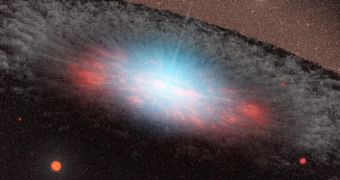Astrophysicists at the University of Arizona in Tucson (UAT) propose that black holes are surrounded by a ring of light, that is made up of photons which are unable to escape the massive gravitational pull of the object, but which have not yet passed through the event horizon.
As such, these elementary particles are spinning around the dark behemoth, scattered by radiation and matter falling through the event horizon to fee the object. If this idea holds true, then it means that black holes are not black after all.
It also means that Stephan Hawking was right when he showed that light radiation (which now bear his name) must be coming out of all black holes. Other astrophysicists proposed that these objects glow more as they decrease in size.
Mathematician Louis Crane even portrayed a future in which small black holes are used as heat and light sources, after all the stars in the Universe withered and died, Daily Galaxy reports.
UAT investigators Tim Johannsen and Dimitrios Psaltis were the ones who discovered the hypothetical ring of light around black holes. They say that large numbers of photons should theoretically be trapped in a circular orbit around the event horizon of such objects.
According to predictions that resulted from their calculations, these ring-like structures are considerably more bright than the average accretion disk, which contains nothing more than super-hot hydrogen gas, cosmic dust, and other matter ripped apart from objects the black hole consumes.
The investigators also proposed that these ring are on average about ten times the diameter of the black hole itself. This means that imaging technologies which will soon be made available to astronomers should be able to make them out. s
If this becomes possible, then astrophysicists will have access to a study method that will allow them to measure the mass of a black hole directly. Scientists will also be able to infer additional data about key characteristics the dark behemoths have by looking at their light rings.
The researchers say that the first such observations will most likely be conducted on the supermassive black hole located at the core of our galaxy, the Milky Way. The object is both massive and located close by, so it makes for an outstanding target.

 14 DAY TRIAL //
14 DAY TRIAL //